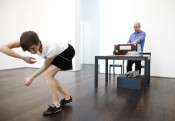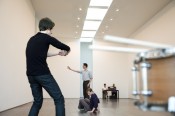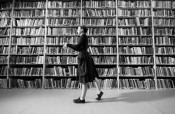1. Verbs
It’s a sunny afternoon in early February. I am sitting on a bench in the main space at the Siobhan Davies Studios, watching choreographer Sue (Siobhan) Davies and dancers Henry Montes, Deborah Saxon and Matthias Sperling at work. They are developing initial ideas for The Collection, a dance piece specially conceived for performance in the ‘white cube’ of the contemporary art gallery, juxtaposed with works of art that reflect in some way on the phenomenon of movement. In a room below, dancer Catherine Bennett and composer and performer Matteo Fargion are similarly occupied, though here, a musical and vocal score that’s intrinsic to the choreography is also being devised. Montes, Saxon, Bennett and Fargion are working in pairs while Sperling is testing out solos and interventions into the others’ dance sequences. Pencil and pad in hand, I’m working too, but my own task is unfamiliar to me. I’m trying to trace relationships between my own specialism, contemporary art, and this other art form, dance – a subject well outside my usual compass. I’m beginning to register the formidable range of questions this project poses about their connections and disjunctions.
Don’t try to analyse, I decide; just describe. At this, Richard Serra’s 1962-8 text piece Verb List – a frankly instrumental inventory of his sculptural processes – sneaks into a back-row seat in my mind and sits itself down, rustling its programme. ‘To roll/to crease/to fold/to store/to bend/to shorten/to twist/to dapple/to crumple/to shave/to tear …’ I compile a list that seems proper to the work process of the Siobhan Davies Dance company. Unsurprisingly, it’s very different from Serra’s; checking later, I find no overlap. ‘To suggest, to show, to describe, to discuss; to watch, to test, to review, to appraise; to share, to mirror, to repeat, to follow; to set aside, to memorise, to refine, to modify; to develop, to prolong, to intensify, to soften …’ Cooperation, fluid communication, reflexivity and the acceptance of contingency characterise the studio’s method. The reflection is persistent, detailed. Backward as well as forward steps are anticipated and sanctioned.
Davies talks me through the plan underlying the dancers’ explorations. The Collection is built from separate, minute-long units. Each unit’s scheme of movement has a focus: not a particular mood or gesture, but an underlying quality that (for now) we opt to call a ‘state’. These are then sequenced in complementary and contrasting relationships (and as the dancers work, I start to notice the careful attention invested in the transitions from one state to another). I wonder if this ‘unitised’ approach would also work for me. Could I pack my ideas into a collection of texts of uniform length? Such textual strategies are a gamble, I know; but maybe The Collection’s formal logic and the subject’s complexity will head off the problems.
2. Disciplines
From the post-war period onward, visual art has comprised so many instances of works that sit between or combine cultural disciplines that one might, paradoxically, cite the deconstruction of disciplinary borders as the dominant characteristic of this era’s art. The welcome extended by the omnivorous, promiscuous art gallery to dance exemplifies the phenomenon well. Take, for example, the critical conceit of Jackson Pollock as ‘dancer’ and action painting as a kind of choreography; or the lessons learned by performance art from the Judson Dance Theatre’s experiments in improvisation and videotaping; or performance art’s borrowing of the ‘task’ aesthetic evolved in the 1960s and ’70s by Judson alumni such as Yvonne Rainer and Trisha Brown. More recent instances include the re-presentation of early ’70s Trisha Brown pieces at the 2007 Documenta XII exhibition, and ex-dancer Tino Sehgal’s much-debated ‘constructed situations’.
That noted, contemporary art’s hospitality has tended to be conditional and the gallery, at times, an overbearing host. Overlooking the concerns of dance, it has steered the conversation towards its own favourite subjects: the deconstruction of expression, authorship, ‘mastery’ or single-point perspectives; the critique of institutions, the dismantling of constructs such as originality, progress, transgression … The dancers are present but their performances construed as an odd kind of crowd control – a means to provoke physical, ideological or institutional self-consciousness in viewers, rather than finely tuned aesthetic artefacts in themselves, objects inviting examination from formal, structural, cognitive and expressive points of view.
The Collection redresses this. The work is conceived and positioned in equal dialogue with works of visual art, not as a correction to ‘regressive’ spectatorial tendencies. Visitors may come and go at will and watch from wherever they wish, and in this sense The Collection reflects the viewing conditions of mainstream video art installations. Nevertheless, like any traditional dance work the piece is repeatable and scriptable, and it holds the critical shibboleths of much fine art spectatorship – ‘repositioning the viewer as participant’, ‘subverting the exercise of the gaze’, ‘undermining the experience of the work as a totality’, et cetera – at arm’s length. Viewers are free to take in an entire, six-hour, day of performance if they choose (and doubtless some will). The setting may cause an initial awkwardness, but the sustained concentration on the properties of movement particular to the reception of dance is not under attack.
Rather, it seems that this might work as a reminder, to the gallery goer, of the possible values of this mode of looking. How does this move work? What are its uses?
3. Gestures
‘Starting points like arrested gestures’ my notes read. ‘A hug/grapple/grab. A tap or touch on the shoulder (greeting/getting attention). Flicking dust from clothes. Tiptoe/headshake. Crawling sequence. Video not mirrors. Montes-Saxon handshake. Handshake persists. Repetition takes on belligerent quality. + Voice. Changing pace/speed – density, variety, surprise? (Making sure the gesture doesn’t lose its particularity).’
Reviewing my script I’m doubtful it’ll be much use in itself, but it reminds me of something I don’t yet understand: how to interpret the relationship between movement and gesture in this choreographic process. It places ‘ordinary’ movements – headshakes, handshakes – ‘under a new title and point of view’ (to borrow a phrase). But their usual meanings are not so much cancelled as transmuted or estranged. Spanning a full sixty seconds, Montes and Saxon’s dogged handshake proves strikingly nuanced and arresting. It mutates, shifts shape: it’s a reconcilement, then a duel, an ordeal, an act of faith. Sue Davies explains the company’s focus on avoiding automatic or unreflective movements, on keeping the performance ‘present’. Hence ‘video not mirrors’: the studio has no mirrors. To experience what they’re doing from the inside the dancers scrutinise their work retrospectively, using video.
Hypothesis: in dance, every movement is gesture. Not as in semaphore or day-to-day body language; rather, every move is an intentionally communicative artefact. Even if the intention is to be blank, cryptic or unfathomable, it still constitutes a kind of message. Next hypothesis: taken literally, the term ‘empty gesture’ is an oxymoron. An ‘empty gesture’ may be as meaningful and valuable as any other since, meaningfully meaningless, it could be intended to signify its lack of significance. Third hypothesis: the concept of ‘poetic gesture’ is also contradictory, in that the meaning of a poetic gesture is exact, and yet open to endless reinterpretation. It is a movement or act (or humanly created artefact) that is intentionally communicative in an absolutely precise, unique way – yet it’s also necessarily open-ended, infinitely self-reinventing.
Back in the studio, I spot Saxon trying something new. Her palms are pressed over her eyes and her torso swivels rapidly, left, right, left, right. I am gripped, moved; the gesture seems to express unbearable distress. Yet simultaneously it’s abstract, puzzling, nonsensical even (using that term in a positive way: the movement escapes ‘common sense’). Is distress being communicated? If so, whose? Not the dancer’s or the choreographer’s; certainly not that of some fictional character, and not mine. Gestures must retain their particularity, I scribble. Headshakes, handshakes: from the point of view of interpretation I feel sure the iconic and expressive conventions still matter. Equally, I feel a strong invitation to discard, to unlearn them. How much, and what, can be retained? How much, and what, need I unlearn?
4. Bodies
In the early planning stages, it was decided that in the works of art selected to accompany The Collection, the theme of movement would be approached crab-wise and allusively, not following some strict formal plan. It was also anticipated that the works on show would not include representations of the human body. They would trace the idea of movement implicitly, via media, processes and inanimate objects.
A shortlist emerged. Turning ephemeral scraps into delicately poised, intricate and rhythmic constructions, the processes evidenced in Sarah Sze’s sculptures might well be said to parallel the spatial operations figured in The Collection’s choreography. Roman Signer’s deadpan manipulations of everyday objects show how simple experiments in the containment and release of energy can generate an unexpectedly charged poetic imagery. Conrad Shawcross’s practice turns on an exploration of algorithms and the potential of simple, finite sets of instructions to give rise to complexity: explorations that stand comparison with the developmental techniques of Davies and her dancers. Operated by a mechanism based on Davies herself dancing, Anri Sala’s Doldrum is purpose-built to cohabit the performance space with the dancers and interject an echo of the choreographer’s own movements into her work.
Outside the Victoria Miro Gallery an aural installation featuring the voice of sound artist Susan Philipsz floats a wistful memorial to the ill-fated dancer Lucia Joyce on the London air. Also outside, floating on the Regent’s Canal, the constantly mobile flock of mirrored spheres that make up Yayoi Kusama’s Narcissus Garden form the basis for a visual meditation on the relativity of chance and control in all creative processes, be they sculptural or choreographic. Indoors, Yusama’s Gleaming Lights of The Souls invites visitors to step inside a gingerbread-house of a chamber whose mirrored walls reflect to infinity galaxies of small, ever-changing coloured lights. It’s an enchanted, seductive environment, but it also hints at scary psychological states: anomie, obsession, anxiety and mania.
However, bodies soon gained admission to the show – maybe inevitably, since the range of signifying practices issued in by the representation of the human body is potentially so rich and diverse. Take, for instance, the visual riddle posed by Francis Alÿs’s two deceptively simple Musical Chairs paintings. Is it the figures, or the painter and the chair, that have danced through a hundred and eighty degrees, in the change from one image to the other? Is this work about human or spatial relationships? (Sure; it’s both, and more besides.) In a similar spirit, Cildo Meireles’s work Atlas establishes a multi-layered monument out of what seems a light-headed spur-of-the-moment physical improvisation. Alex Hartley’s consuming passion for climbing has been translated, for this show, into a video edited from film footage of urban climbing – for him a new way of focusing on themes of control, risk and escape in the act of climbing. And artist Idris Khan and Siobhan Davies Dance alumna Sarah Warsop’s jointly authored work Lying in Wait – an exploration of dance-making mediated by film- and video-making, and vice versa – promises to offer an absorbing counterpoint to the company’s live performance within the same exhibition.
5. Intentions
Are works of visual art also ‘gestures’? Why not think of them that way? Both gestures and works of art are underwritten by an assumption that they intend a communication. But who or what is doing the intending?
In practice in most art criticism (including mine, I confess it) the construction of intentionality tends to be haphazard. At one moment an artist’s intention (be it conscious or unconscious, stated or implicit) is cited as proof that a work means X. At the next this approach is set aside and general or specific cultural conventions invoked as evidence that another work means Y. The critic then hypothesises that the artist’s intention should have been Z (even if it probably wasn’t) and goes her merry way. In yet another scenario, the work itself is attributed intentions; it becomes the intending subject – a spooky, multi-lingual ventriloquial device that apparently has no one at the controls.
When I attend a gallery preview of Idris Khan and Sarah Warsop’s project Lying in Wait, the contrast between my own happy-go-lucky interpretive habits and those of my dance-specialist companions is thrown into relief. Because Lying in Wait is a three-screen video installation based on 16 mm film footage of a dance piece developed and performed by Warsop. Khan has set the performance in a purpose-built ‘library’ and has intensified its choreographic concerns through his editing processes (including, importantly, the treatment of sound). By the end of the screening I’m itching to characterise and contextualise what I’ve seen. History of lens-based media here; contemporary ‘archival art’ practices there; then some quick forays into sound art, the history of dress, spirit photography, a dash of psychoanalysis. This garment seems antique, that set seems looming, uncanny; this movement seems desolate, this nervous, repressed; that action seems ruthless, and that like a conclusion – etcetera. But my companions are reflecting carefully and precisely on the demonstrable physical properties of the presentation: changing paces and speeds, densities, varieties, repetitions and transitions. Before undertaking interpretive judgements about affects and significances, the formal scaffolding of the work must be thoroughly examined and considered.
And so, I am learning, too. The Collection flags the continuing importance and critical potential of disciplinary foci. As a project, it brings disciplines into a comparative relationship, not one of (false) interchangeability. Placing contemporary dance within the gallery shows how the discipline can look again at the simplest of movement patterns and invest it with unaccustomed intensity and aesthetic value. In this choreography, to borrow a phrase from Davies, ‘movement habits’ are ‘fought against hard’. Stringently formal methods of making and looking seem to be key to this process. Such approaches tend to get viewed askance by contemporary art as artefacts from a previous, modern, age of disciplinary propriety. That’s a habit to ‘fight against hard’, because they are clearly a valuable existing component in contemporary art’s repertoire of critical practices. Finally, though, I am left still wrestling with the conundrum I perceive at the core of contemporary dance: its paradoxical embodiment of the abstract right in the heart of the physically particular, the movements of the individual human body. But at the time of writing The Collection is an experiment still to be realised. The performance itself is waiting, in the future, with potential answers to my questions.
Text © Rachel Withers, 2009


